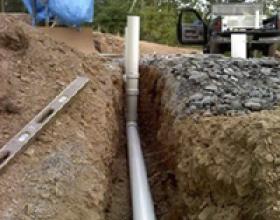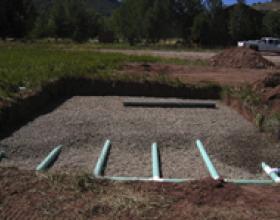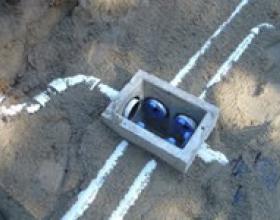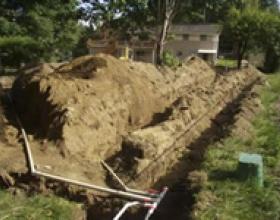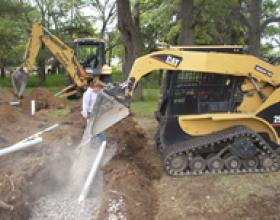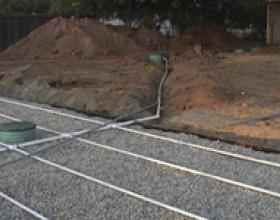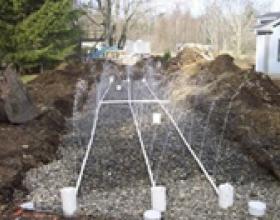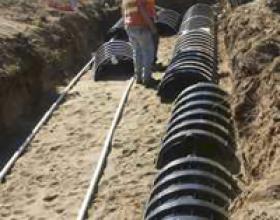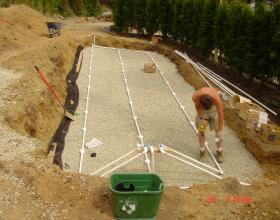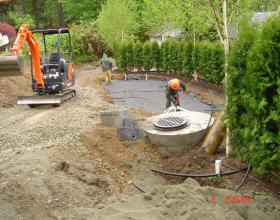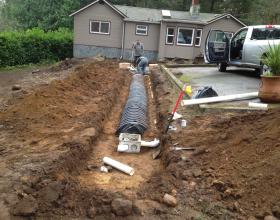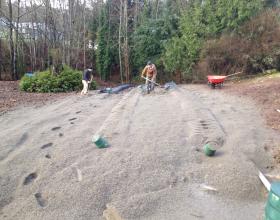Pacific Group Developments wants to help educate our clients about the process, parts, materials, installation and assembly of septic fields and leach fields. This page is designed to help you understand what you need to know about septic fields and leach fields.
About Septic Fields
A septic field is also known as a leach field, disposal field or drain field.
A septic field is a receiving area for effluent after it has broken down and been treated in a septic tank or septic treatment plant. This area receives liquid effluent to be further treated in the ground and then returned into the natural water cycle. Aerobic bacteria are able to thrive and treat effluent in the ground of the septic drain field or leach field. The retention time in the ground is an important variable that’s used in the calculations for the size and type of the field.
Types of Septic Fields
Gravity System -The most common type of septic field of the past is also the most basic. It’s built with a 4” perforated PVC pipe laid in trenches approximately 30” deep and 16” wide and filled with .75” to 1.5” drain rock. The trenches are usually spaced about 6 feet apart until the desired length of runs is achieved to meet the demands. This system is gravity fed and requires no pumping. With this type of system it’s difficult to attain 100% efficiency in effluent delivery. Usually effluent travels a short distance down the pipe and enters the field before making it to the end of the pipe and using the field evenly.
Pressure Distribution System -A pressure distribution system uses an electric sewage effluent pump to pump from the tank or the pump chamber into the drain field, which pressurizes all the pipes evenly. The pipe is usually 1” or 1.25” PVC with 3/16” holes drilled every 2 to 3 feet from which the effluent is discharged into the pressure distribution septic leach/leach field. This system uses your whole septic drain field evenly, which enhances treatment and prolongs the life of your septic drain field. There are several types of septic drainfields, which work well with the pressure distribution septic system.
Pressure distribution is a preferred method for disposal fields that are located higher than the septic tank or on lots that require shallow placement of the septic leach/leach field. Another benefit of the pressure distribution septic system is the dosing and resting cycles (which refers to pumping effluent and then resting). This prolongs retention times in the septic tank, which helps in the breakdown of sewage and the time in the septic field.
A pressure distribution septic system can be used in trenches, beds or raised mounds of course sand, as well as gravel.
In areas with poor or shallow soils a pressure distribution a pressure distribution septic system will be required because 100% of the septic drain field is being used. Once installed, the system must be carefully balanced to create even pressure throughout the field.
Some situations call for the use of plastic vaults, or baffles made of plastic, to create a dome shape above the pipe running above it a parallel direction. There are variations of this concept depending on the manufacturers, but they all achieve the same, which is a larger receiving and retention area around the pipe.
Sand Filter Septic System -Sand filter systems can be installed above or below the ground and is based upon a principle similar to that of a mound system. The pump chamber and the drainage field is separated by sand, So the effluent that discharges from the pump tank gets pretreatment by the intermediate sand before it enters the drainage field. The system can be regarded as a biological treatment for natural cleansing of effluent. A sand filter system is a good alternative in places where the soil is insufficient for wastewater treatment. This is because the sand that is used in the process makes up the dearth of soil.
Mound Septic System - Certain areas cannot provide conditions where soil is deep enough for installation of traditional septic systems. For such places the mound septic system is well suited. With this septic system the drainage system is raised above the natural soil surface or ground level. On top of the natural soil, specific sand fill material is placed for the effluent or wastewater treatment.
The sand fill consists of a gravel bed, which in turn consists of a network driven by pressurized pipes. The septic tank’s effluent reaches the mound through the pump in a dosing tank. The pump ensures controlled doses for uniform distribution throughout the gravel bed. So the waste gets filtered when it traverses through the sand fill and into the natural soil.
Septic Pump Chamber
The septic pump chamber holds onto the effluent until pre-measured doses are built up. Those doses cause a float switch to engage the pump, which then pressurizes the septic pressure distribution system and loads the septic disposal field. Once the sewage effluent levels are lowered in the pump chamber the flood switch disengages the pump. The pump chamber is left with room to refill, while the drain field is now treating the effluent.

